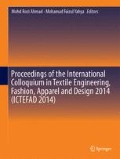Abstract
Natural fibers have gained attention in composite making since they are sustainable, renewable, and environmental friendly. However, there are some drawbacks such as low tensile strength, modulus, and flexural strength compared to industrial synthetic fibers. Various techniques have been used to increase the mechanical properties of the reinforced material to compete with synthetic fibers. This study produces reinforced fabric made from kenaf fibers woven into four different weave patterns. The reason for the use of different weave patterns is to reduce the crimp percentage as it may increase the tensile strength of the fabric. The weave patterns are Twill 4/4, Satin 8/3 and Basket 4/4. Plain 1/1 is used as the benchmark. The dry fabric structure with different weave patterns was optimized using a simulation of WiseTex software. The dry fabrics were infused with unsaturated polyester (UPE) to produce composite panel using vacuum infusion process (VIP). The dry fabric and the composites were tested for tensile strength and compared with the plain 1/1 weave pattern. The results show that the breaking strength of dry fabrics increased when different weave patterns with low crimp percentages were used compared with Plain 1/1. However, in composite form, there is a reduction in the tensile strength of Basket 4/4. The other weave patterns still retain the trend of increment in tensile strength compared with Plain 1/1 weave.
Access this chapter
Tax calculation will be finalised at checkout
Purchases are for personal use only
References
A.K. Mohanty, M. Misra, G. Hinrichsen, Biofibres, biodegradable polymers and biocomposites: an overview. Macromol. Res. 276–277, 1–24 (2000)
A. Causa, A. Netravali, Characterization and measurement of textile fabric properties, in Structure and Mechanics of Textile Fiber Assemblies, ed. by P. Schwartz (Woodhead Publishing Limited, Cambridge, 2008)
M.H. Peerzada, S.A.A.A. Khatri, Effect of weave structure on tensile strength and yarn crimp of three-dimensional fibre woven fabric. Sci. Int. (Lahore) 24, 47–50 (2012)
P. Vandeurzen, J. Ivens, I. Verpoest, A three-dimensional micromechanical analysis of woven fabric composites: 1. Geometric analysis. Compos. Sci. Technol. 56, 1303–1315 (1996)
Ž. Rukuižienė, R. Milašius, Influence of reed on fabric inequality in width. Fibres Text. East. Eur. 14, 44–47 (2006)
B.K. Behera, J.M.R. Mishra, D. Kremenakova, Modeling of woven fabrics geometry and properties, in Woven Fabrics, ed. by H.Y. Jeon (InTech, Croatia, 2012), pp. 1–32
L.B. Manfredi, E.S. Rodríguez, M. Wladyka-Przybylak, Thermal degradation and fire resistance of unsaturated polyester, modified acrylic resins and their composites with natural fibres. Polym. Degrad. Stab. 91, 255–261 (2006)
A.A.A. Rashdi, S.M. Sapuan, M.M.H.M. Ahmad, A. Khalina, Water absorption and tensile properties of soil buried kenaf fibre reinforced unsaturated polyester composites (KFRUPC). J. Food Agric. Environ. 7, 908–911 (2009)
S. Lomov, I. Verpoest, F. Robitaille, Manufacturing and internal geometry of textiles in design and manufacturing of textile composite, in Design and Manufacture of Textile Composite, ed. by A.C. Long (Woodhead Publishing Limited, Cambridge, 2005), pp. 1–61
H. Reinforcements, Technical Fabrics Handbook (Hexcel Reinforcement for Composites, Texas)
T. Ngai, Carbon-carbon composite, in Handbook of Composite Reinforcements, ed. by S.M. Lee (Wiley, New York, 1993), pp. 41–70
J. Hu, Structure and Mechanics of Woven Fabrics (Woodhead Publishing Limited, Cambridge, 2004)
Acknowledgment
The authors are grateful to the Faculty of Mechanical and Manufacturing Engineering and Advanced Textile Training Centre, Universiti Tun Hussein Onn Malaysia; Faculty of Chemical Engineering and Centre for Composite, Universiti Teknologi Malaysia; Department of Mechanical Engineering, Politeknik Seberang Perai; and Department of Metallurgy and Materials Engineering, Katholieke Universiteit Leuven for the WiseTex software.
Author information
Authors and Affiliations
Corresponding author
Editor information
Editors and Affiliations
Rights and permissions
Copyright information
© 2014 Springer Science+Business Media Singapore
About this paper
Cite this paper
Saiman, M.P., Wahab, M.S., Wahit, M.U. (2014). The Effect of Fabric Weave on the Tensile Strength of Woven Kenaf Reinforced Unsaturated Polyester Composite. In: Ahmad, M., Yahya, M. (eds) Proceedings of the International Colloquium in Textile Engineering, Fashion, Apparel and Design 2014 (ICTEFAD 2014). Springer, Singapore. https://doi.org/10.1007/978-981-287-011-7_5
Download citation
DOI: https://doi.org/10.1007/978-981-287-011-7_5
Published:
Publisher Name: Springer, Singapore
Print ISBN: 978-981-287-010-0
Online ISBN: 978-981-287-011-7
eBook Packages: Chemistry and Materials ScienceChemistry and Material Science (R0)

